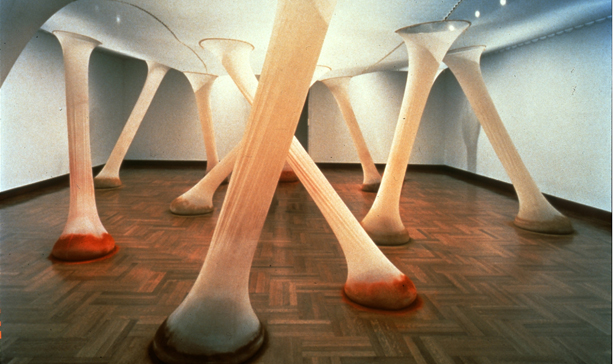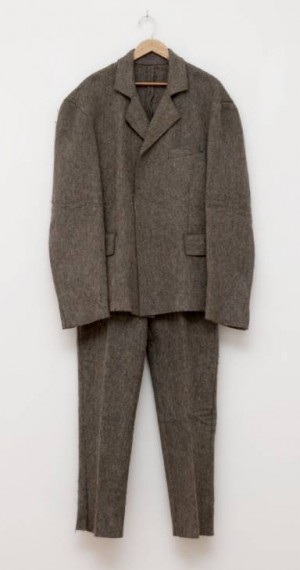You have no items in your cart. Want to get some nice things?
Go shopping

The body is an enduring theme in art, from Egon Schiele’s exquisite but confrontational masturbation works, to Mark Quinn’s queasy frozen-fluid casts. The current show at the Scottish National Gallery of Modern Art, From Death to Death And Other Small Tales, features works from the collection of D. Daskalopoulos alongside many rarely-seen major pieces from the Scottish National Gallery of Modern Art. It includes artists who have shaped 20th and 21st -century culture, each responding in various ways to the great mysteries of the physical and psychological self; that duality of tissue and thought that fundamentally constitutes who we are.
The most poignant works in this show tell tales of vulnerability: the reduction of our selves to a sum of temporal parts. Slit wrists lie on a cold narrow bed in Kiki Smith’s Bed with Arms (1996), Rene Magritte crowns the body of a young girl with a grinning skull for his La gâcheuse (1935), while elsewhere a single breast adorns the cover of an exhibition catalogue from 1947, resembling a piece of meat, with the caption “Prière de Toucher” [Please Touch]. Marcel Duchamp’s works can often be relied upon to poke fun at art gallery etiquette, even while saying something more meaningful. Here this excised breast somehow betrays the signature irreverence of the artist.
Sarah Lucas’ stuffed stocking creations comment on the male gaze, part of a critique of female nudity that has dominated Western art for centuries. In Bunny gets Snookered #10 (1997) a near-human pair of legs is slumped over a chair with red hold-ups and floppy ears where a head should be. It’s like Duchamp’s piece of meat all over again: a marked critique of the female form has been reduced to mere titillation. While I’m a big fan of art that disturbs the viewer, it’s a toss-up between Bunny and Lucas’ other featured sculpture, Nud… (2010), as to which one wins the Freud Award for Most Uncanny.
Then there are the pieces which present the body on a grandiose scale, offering more universal interpretations of our insides. In Ernesto Neto’s It happens when the body is an anatomy of time (2000), wandering through netted stalks makes you feel like an extra from Innerspace, exploring the tubes and vessels of the body writ large. The membrane-like stalks are weighed to the floor with a combination of turmeric and other spices, giving off a potent smell, which strike me as an unnecessary distraction, superfluous to what is an absorbing visual and physical experience.
Elsewhere I found myself actually imagining a clinical, soapy fragrance as I watched Marina Abramovic’s “Cleaning the Mirror” (1995). Five TV screens depict someone scrubbing a skeleton from top to bottom. There are plenty of sinister children’s toys and visceral objects seen here in D. Daskalopoulos’ collection, but these sparkling, squeaky bones create an uncomfortable lump in the throat. Perhaps they are a reminder of our collective fate – the ultimate reduction – or just something stripped of all living matter: clean but soulless.

In other rooms, the body is notable by its absence. Untitled (1998), by Doris Salcedo, is a chair subsumed into a concrete-filled wardrobe as though pulled into some sort of horrific Narnian dimension, while Joseph Beuys’ Felt Suit (1970) draws attention to the space within it, reminding me of a Felix Gonzalez piece I once saw: a pillow with an indent of a head had previously lain. These very human objects are empty, functionless, without the people to whom they belong. Perhaps this is where the titular “Death” is being confronted.
At its best, this exhibition demystifies the human body, laying it open, bare and frank, but even the works that explore the potential ugliness of the body are striking in their beauty. Kiki Smith’s body sculpture displays its innards across the floor like party poppers; it had both a both gut-wrenching and dispassionate effect. At it’s most baffling, cheery genital wallpaper lines one of the galleries, while in another I find what is basically a pirate orgy projected on the opposite wall. The shocked faces of the middle-class, gallery-going public, lit up like a row of startled dolls, is easily the most entertaining part of this experience.
If like me you’ve ever wondered at how all those elaborate processes keep chugging along inside you, seemingly without your knowledge or input, this is the exhibition for you. It’s strange to be confronted with the mystery of our bodily functions and desires – things we often laugh about and dismiss when considered in the abstract – but here it is also oddly reassuring. Displayed here, in various forms, is our ultimate commonality as a race; to put it another way, we’re all in this life and death business together.
From Death to Death and Other Small Tales | Masterpieces from the Scottish National Gallery of Modern Art and the D.Daskalopoulos Collection is on at the Scottish National GAllery of Modern Art until 8th September 2013, admission free.

About Laura Gavin
Laura is a freelance copywriter based in Edinburgh. She has contributed articles for LeftLion, with stories in fairytale anthology Homespun Threads and recorded on Outside Thoughts. Blogs on daft web content and funny textual nuggets at foundfunnies.wordpress.com. She used to be an art student in a previous life and still enjoys paper and different coloured pens.





‘From Death to Death and other Small Tales’ Laura Gavin @oddleg13 reviews current show @ Scottish National Gallery – https://t.co/KqNcoFerDZ